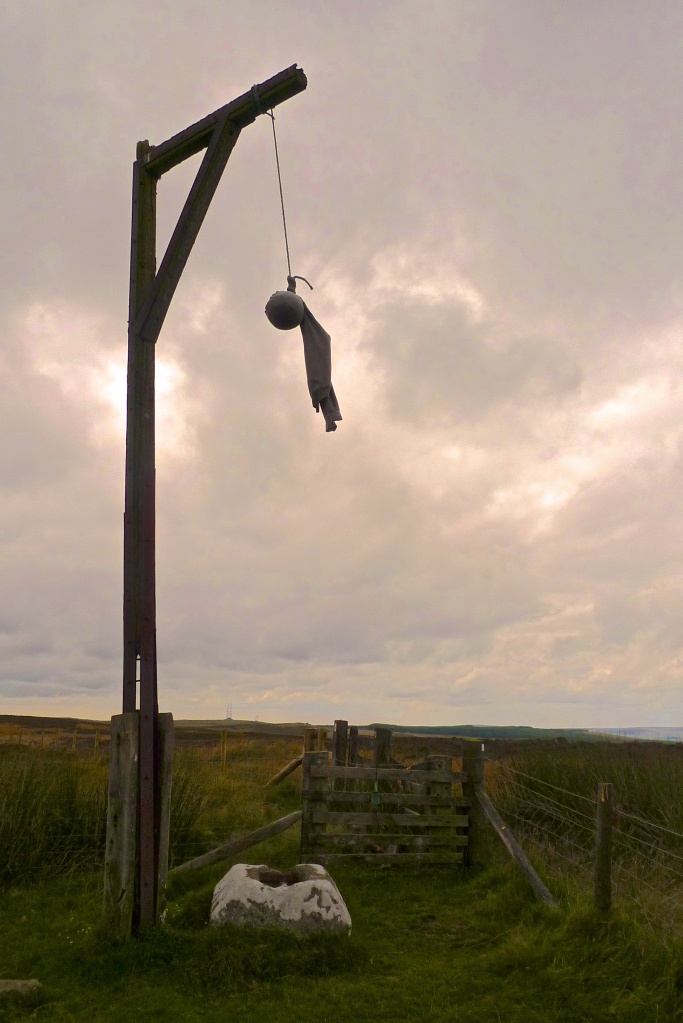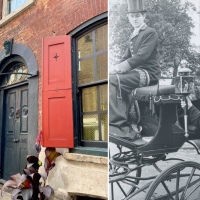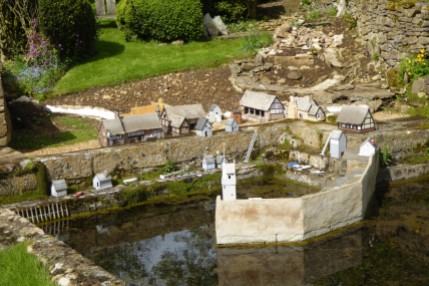Winter’s Gibbet at Elsdon is a stark and shocking sight.
The gibbet with its hanging figure silhouetted against the cruel grey sky sends a shiver down your spine as you drive over the moors on Northumberland’s Whiskershields Common.
This is crime and punishment 18th Century style – brutal and uncompromising.
The original gibbet was erected in 1792 to suspend the body of William Winter who had murdered an old woman, Margaret Crozier in the nearby village of Raw.
Winter was hanged for the crime in Newcastle and his dead body was taken in chains to the moors of Northumberland where it was displayed as a warning to other criminals.
It must have been a grisly sight which locals would have been able to see from miles around.
Crime and punishment
Nobody knows exactly how the murder happened – the fine details have been lost in the mists of time.
Some amateur historians say that Margaret Crozier was strangled although other accounts suggest the old woman’s throat was cut. Either way it was a horrendous crime.
William Winter was a long-term criminal who had already been in trouble for a string of crimes including burglary and stealing an ass.
The Elsdon gibbet was built for him alone – nobody else was to hang from its wooden frame.
Today’s gibbet is a modern replica complete with a hanging figure covered in cloth.
The original gibbet deteriorated and was replaced by a replica in the 1800s by Sir Walter Trevelyan of Wallington but that structure also disintegrated, hence the current version.
Local superstition says that wooden chips from the old gibbet were used as a cure for toothache.
The last gibbet
The bleak moorland around Wilson’s Gibbet is reminiscent of the blasted heath in Macbeth.
As you walk across the heather you half expect to see one of Shakespeare’s witches appear from behind a thorny bush with a glowering expression.
The gibbet is a strange sight that lingers in the mind long after you leave the moors.
After the trip I was intrigued to know more about the history of gibbets and how they were used as a form of punishment.
After extensive internet research I found out that the last man in England to be displayed on a gibbet was William Jopling in 1832.
What is particualrly shocking is that he was strung up on a gibbet just six miles down the road from where I’m typing this blog post!
Jopling was a miner who murdered a local colliery owner.
After being hanged his body was covered in pitch, hung in chains and taken to Jarrow Slake where it was displayed in an iron cage on a gibbet.
My next challenge is to find the site of the Jarrow gibbet… more on that in a future blog post.
I’ll be starting at South Shields Museum where there is a display about Jopling which includes the original gibbet.
I’m not generally one for macabre murder stories but these historic tales of crime and punishment are fascinating because of what they say about our society’s changing views on life, death and morality.
All life – and death – is present in these monuments to the past.
Tammy’s top tips
- Winter’s Gibbet lies 12 miles south west of Rothbury at Steng Cross near Elsdon in Northumberland National Park.
- There’s a parking bay on the main road opposite the site. The gibbet is 100 metres walk from the lay-by.
- Look out for Heritage Open Day walks around the gibbet and associated sites including a forthcoming five mile excursion on Friday 7 September 2012.
- There are other walks in the area including the Redesdale Trails which include the gibbet on their routes.
- Look out for the base of the gibbet which is part of an Anglo-Saxon cross.
Crime tours
If you’re interested in crime and punishment here’s a list of sites of potential interest dotted around the UK:
* Castle Museum, York – there’s a fascinating display about the history of the gaol including a trip down into the cells of York Castle Prison which once housed highwayman Dick Turpin.
* Nottingham’s Galleries of Justice is one of the best attractions I’ve seen of its type and includes the old courthouse, gaol and dungeons.
* The Clink in London is built on the site of the actual prison which dates back to 1144. The museum has a data base of former in-mates so visitors can check if their nearest and dearest were incarcerated here. Well worth a visit.
* York Dungeon – the “immersive” 70 minute tour takes in the city’s grim history including executions and torture. Not for the faint-hearted, this theme park style experience is fun for families, if you’re in the right mood. Others will find it a bit tacky.
* London Dungeon – very similar to the York Dungeon but with London displays. There’s a boat ride to Hell and an interactive Jack the Ripper tour which scared the living daylights out of me when I went a few years ago!
* Madame Tussaud’s Chamber of Horrors in London used to be the innovator in crime and punishment tourism. Sadly it’s a pale shadow of its former self despite the historic exhibits and interactive experiences. Now tacky rather than nerve-jangling.
Categories: History, Northumberland, UK
























Hi! I understand this is sort of off-topic however I had to
ask. Does managing a well-established website such as yours require a lot of work?
I am completely new to running a blog however I do write in my journal every day.
I’d like to start a blog so I can share my personal experience and thoughts online. Please let me know if you have any suggestions or tips for brand new aspiring blog owners. Thankyou!
Hi Barbie 2… Quite a bit of work is required but Word Press templates are easy to use and you can start simply, as I’ve done. The best advice is to write as often as you can – about 2-3 times a week – to keep the momentum and interest going. The site management is relatively straight forward especially if you keep adding tags so it’s easy to find old posts and topics. Promoting the blog on Twitter and Facebook also helps a lot. I’d also recommend writing shorter posts than mine – as they tend to be a bit rambling! Hope that’s helpful. Tammy x